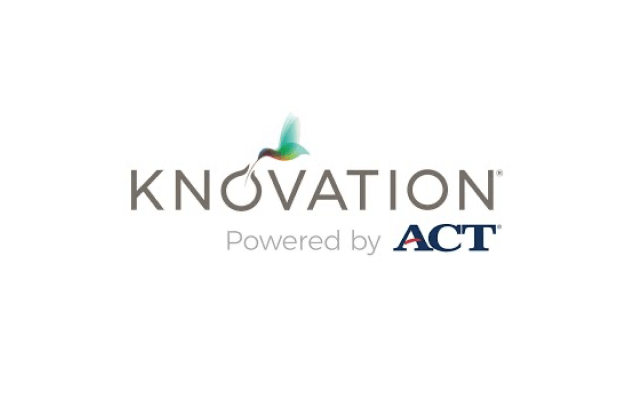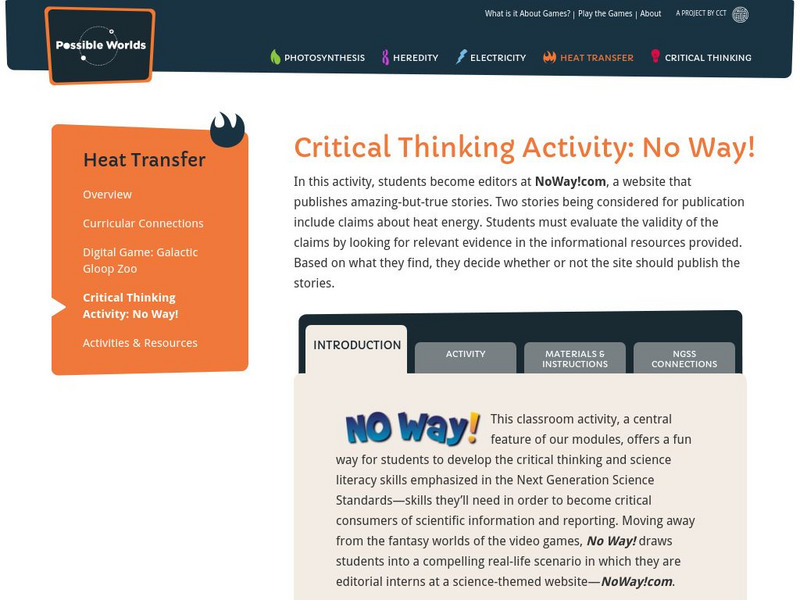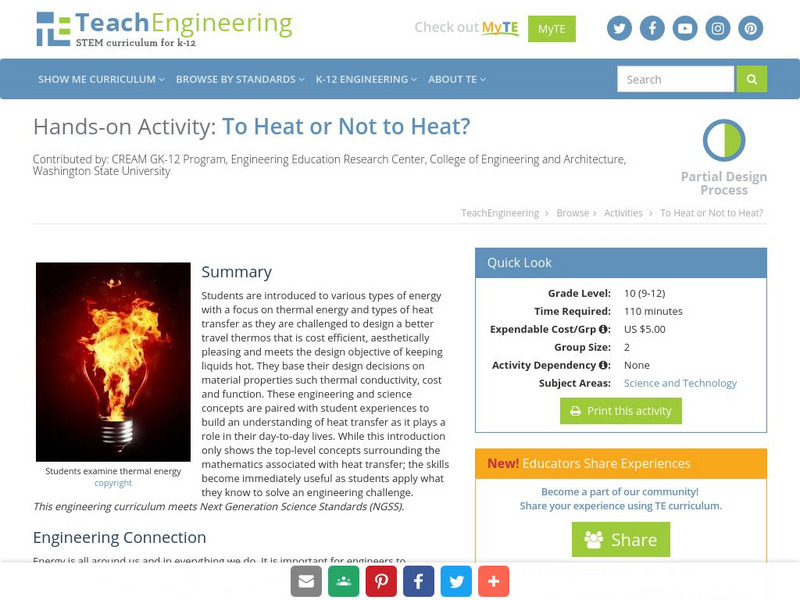PBS
Pbs Learning Media: Heat Transfer
Learn about thermal energy, also known as heat or heat energy, and the ways in which it can move from one object to another,
TeachEngineering
Teach Engineering: Energy Conversions
Students evaluate various everyday energy conversion devices and draw block flow diagrams to show the forms and states of energy into and out of the device. They also identify the forms of energy that are useful and the desired output of...
Utah Education Network
Uen: Trb 3:5 Investigation 4 Heat Misconceptions
Gloves do not give heat, but will insulate or hold in any heat that is in your hand.
BBC
Bbc Schools: Ks2 Bitesize: Science: Materials: Heat
A short, illustrated tutorial about how heat energy moves. After reading the material, take a quick quiz to check for understanding.
Education Development Center
Center for Children and Technology: No Way: Heat Transfer
For this heat transfer activity, young scholars become editors for a website that publishes amazing-but-true stories. Two stories being considered for publication include claims about heat energy. Students must evaluate the validity of...
Science Buddies
Science Buddies: Put Some Energy Into It! Use a Calorimeter to Measure
In this science fair project, use a calorimeter with an attached heating element to measure how water responds to added thermal energy.
National Geographic
National Geographic: Using Waste Heat to Generate Electricity
Students learn about waste heat capture, how it can be re-used to generate electricity and develop a podcast educating others about it. Includes student handouts and links to many online resources.
PBS
Pbs Learning Media: Heat Transfer
In this interactive activity adapted from the Wisconsin Online Resource Center, students will learn how heat can be transferred in one of three ways: conduction, convection, and radiation.
OpenSciEd
Open Sci Ed: 6.2 Thermal Energy
This Thermal Energy unit has students investigating two ways to transfer energy into a drink: (1) the absorption of light and (2) thermal energy from the warmer air around the drink. They are then challenged to design their own drink...
Concord Consortium
Concord Consortium: Molecular Workbench Showcase: Heat and Temperature
A tutorial that explores the concepts of heat and temperature, the transfer of energy between substances, the relationship of temperature and the movement of atom, and thermal radiation. The tutorial includes animations, interactive...
European Space Agency
European Space Agency: Impress: Heat Transfer
Learn about the transfer of thermal energy through concise information, and illustrated animations. Contains descriptions of conduction, convection, and radiation.
Texas Education Agency
Texas Gateway: Law of Conservation of Energy: Heat Transfer
Given illustrations, scenarios, descriptions, and/or diagrams, students will demonstrate understanding of heat transfer.
CK-12 Foundation
Ck 12 Exploration Series: Simulations: Physics: Hot Oven
[Free Registration/Login Required] Do you know why the metal in the oven burns your skin but the air in the oven doesn't? This simulation will show you the relationship between heat energy and temperature.
Science Struck
Science Struck: Examples of Thermal Energy
Describes examples of thermal energy in the natural world from the Sun, the oceans, and the Earth.
Scholastic
Scholastic: Study Jams! Science: Energy, Light and Sound: Heat
A video and a short quiz on heat, covering its difference from temperature, thermal energy, and the means by which heat is transferred.
University of Waterloo (Canada)
The University of Waterloo: The Heating Curve
The heat of vaporization along with several other thermal properties are explained. Sample problems are given. Illustrations.
TeachEngineering
Teach Engineering: To Heat or Not to Heat?
Students are introduced to various types of energy with a focus on thermal energy and types of heat transfer as they are challenged to design a better travel thermos that is cost efficient, aesthetically pleasing and meets the design...
Simon Fraser University
Chem1 Virtual Textbook: Energy, Heat, and Temperature
As part of a larger resource called "Getting started in Chemistry," this page examines various topics related to energy. The types of energy discussed include kinetic, potential, thermal, and chemical.
TeachEngineering
Teach Engineering: Solar Power
In this activity, students learn how engineers use solar energy to heat buildings by investigating the thermal storage properties of some common materials: sand, salt, water and shredded paper. Students then evaluate the usefulness of...
TeachEngineering
Teach Engineering: What Is Heat?
Students learn about the definition of heat as a form of energy and how it exists in everyday life. They also learn about the three types of heat transfer as well as the connection between heat and insulation.
American Chemical Society
Middle School Chemistry: Heat, Temperature, and Conduction
Explore heat, temperature, and the conduction of thermal energy through different materials.
CK-12 Foundation
Ck 12: Heat Transfer
[Free Registration/Login may be required to access all resource tools.] Students explore the relationship between heat and energy transfer, and learn about the three ways that heat can be transferred between objects of different...
TeachEngineering
Teach Engineering: Energy
Through nine lessons, students are introduced to a range of energy types--electrical, light, sound and thermal-as well as the renewable energy sources of wind, hydro (water) and solar power. Subjects range from understanding that the...
Climate Literacy
Clean: Zero Energy Housing
Young scholars investigate passive solar building design with a focus solely on heating. Then they design and build their own model houses, and test them for thermal gains and losses during a simulated day and night.


















